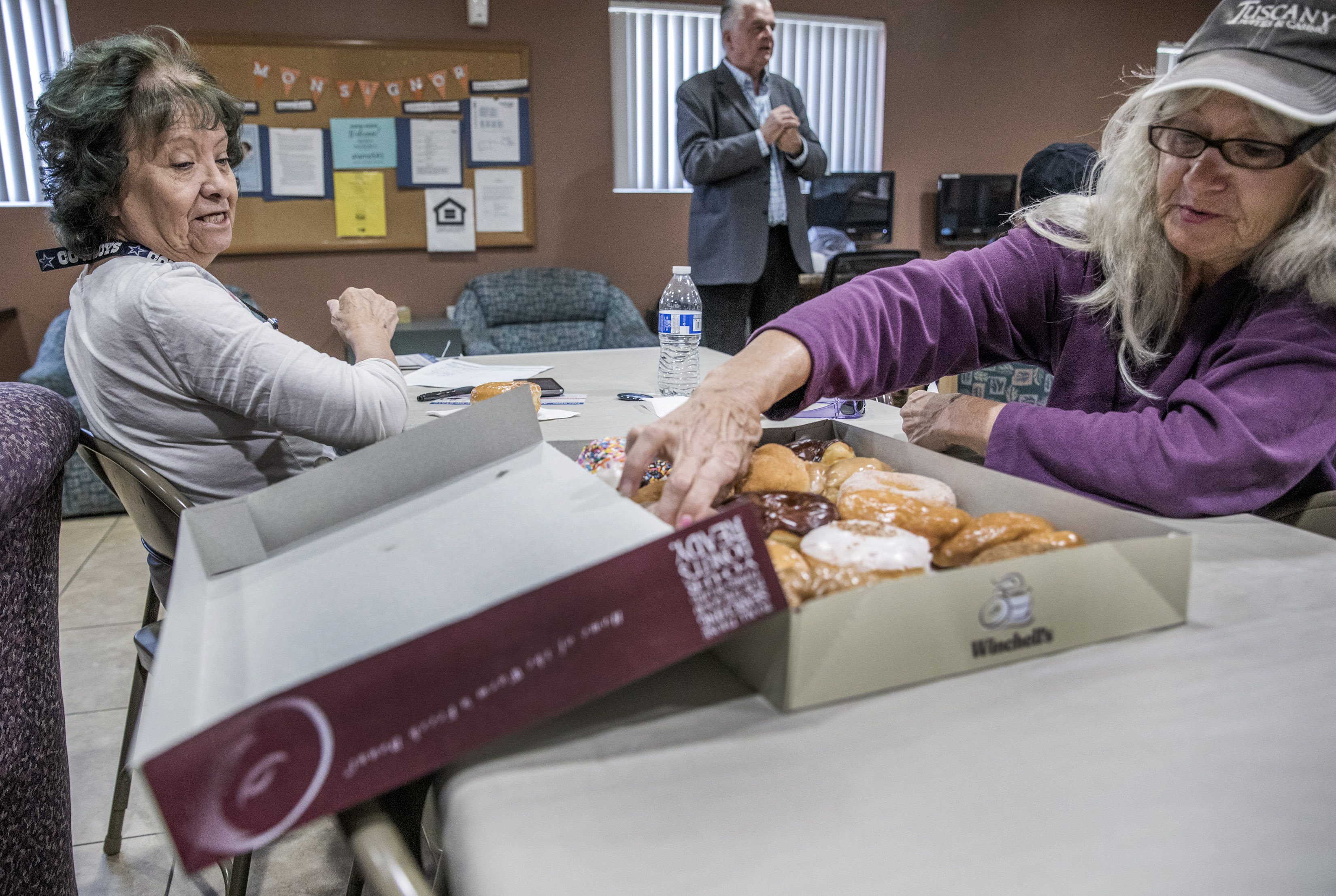Front runners in country's most competitive governor's race are a study in contrasts
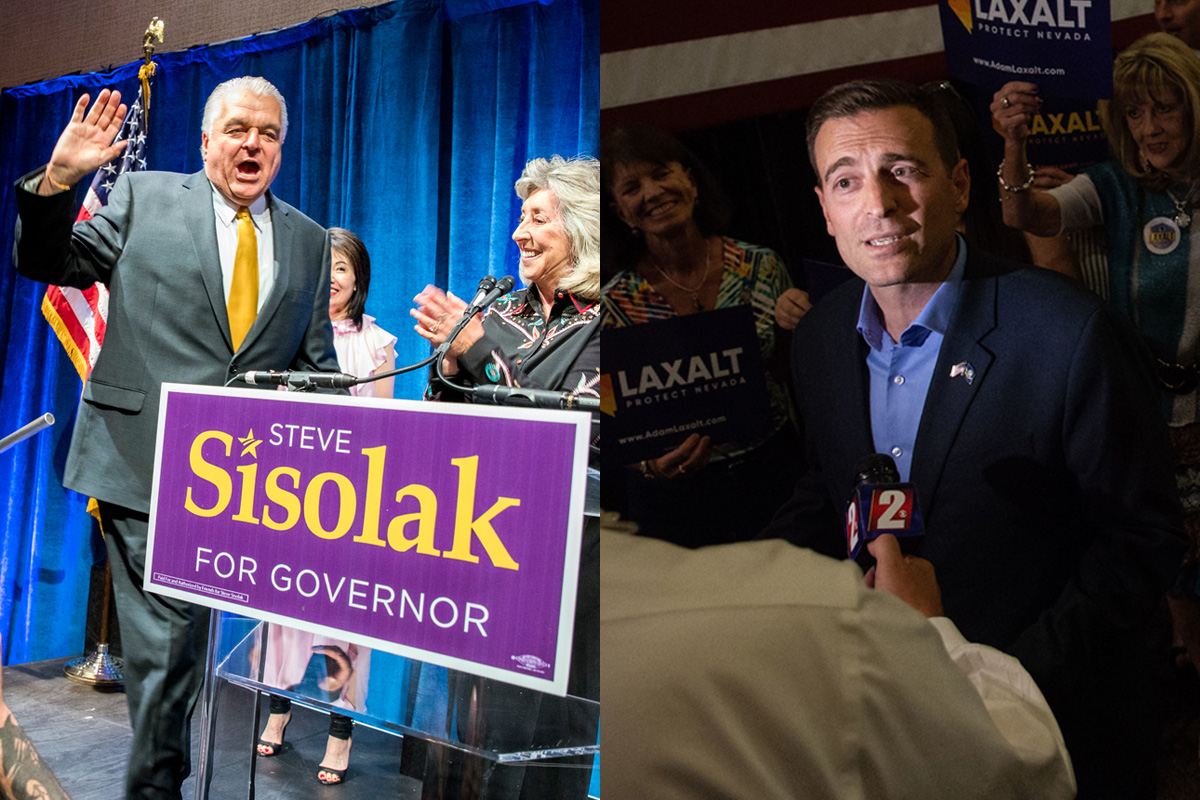
On one hand, there is Steve Sisolak, the self-assured, 64-year-old Clark County Commission chair who has scaled the political ranks in the Democratic Party over the last 25 years before launching his campaign for governor.
On the other, there is Adam Laxalt, the 40-year-old, first-term Republican attorney general who arrived in Nevada seven years ago but whose family name, conservative bona fides and patrons may propel him to victory even though he shies away from the public spotlight.
The two men seeking to hold the highest elected office in Nevada are a study in contrasts, and their race for the open seat held by termed-out Gov. Brian Sandoval is rated the closest governor’s contest in the nation.
“I wouldn't even say we're guardedly optimistic. I would say we're very guarded,” said the AFL-CIO’s Rusty McAllister, whose groups are supporting Sisolak. “These races are extremely close.”
At a short campaign stop in an East Las Vegas senior apartment complex on Tuesday, Sisolak sat down for an interview of about 15 minutes. Laxalt has taken a different tack on the trail — while he opens for big-name campaign rallies headlined by President Donald Trump or Vice President Mike Pence, he rarely grants interviews, and his campaign team did not respond to requests for information or interviews for this story.
He is also seldom heard in his own campaign commercials, which more often feature his wife or a narrator. An analysis of commercials through last Wednesday shows that Laxalt’s voice is heard in less than 3 percent of general election spots broadcast in the campaign so far. Sisolak’s booming voice, by contrast, is heard in more than 95 percent of the commercials that have aired.
And the two have not debated — something that is unheard of for a close Nevada governor race in at least the last 35 years.
But even if the attorney general shirks the limelight, the tight race is evidence that Laxalt’s message has cut deep with voters. In a year where Democrats are expected to easily secure control of both chambers of the Legislature, Laxalt cast himself as the only person standing in the way of Democratic control that would make the state look like California — a place where Republicans are largely sidelined.
“We can go the way of California, high taxes, more regulations, crazy ideas,” Laxalt said at a rally last week. “Or, we can choose the path of the Nevada that we all love.”
Sisolak has capitalized on the fact that the popular Sandoval has declined to endorse fellow Republican Laxalt, featuring the moderate governor’s smiling face in commercials and vowing to continue the work that he did on education and health care.
“I think he’s tried to bring people together, which is what I want to do … I believe as he does that compromise is not necessarily a bad word,” Sisolak said. “Adam comes from a different mold than I do. He’s winner take all.”
Whoever wins will have immense power in a state where a full-time governor builds and recommends a budget for review to a part-time Legislature, setting an agenda that could shape the future of Nevada’s schools, economy and social safety net. Interviews and a review of both men’s past accomplishments give a glimpse of what Nevadans might expect from whoever emerges the victor on Tuesday night.
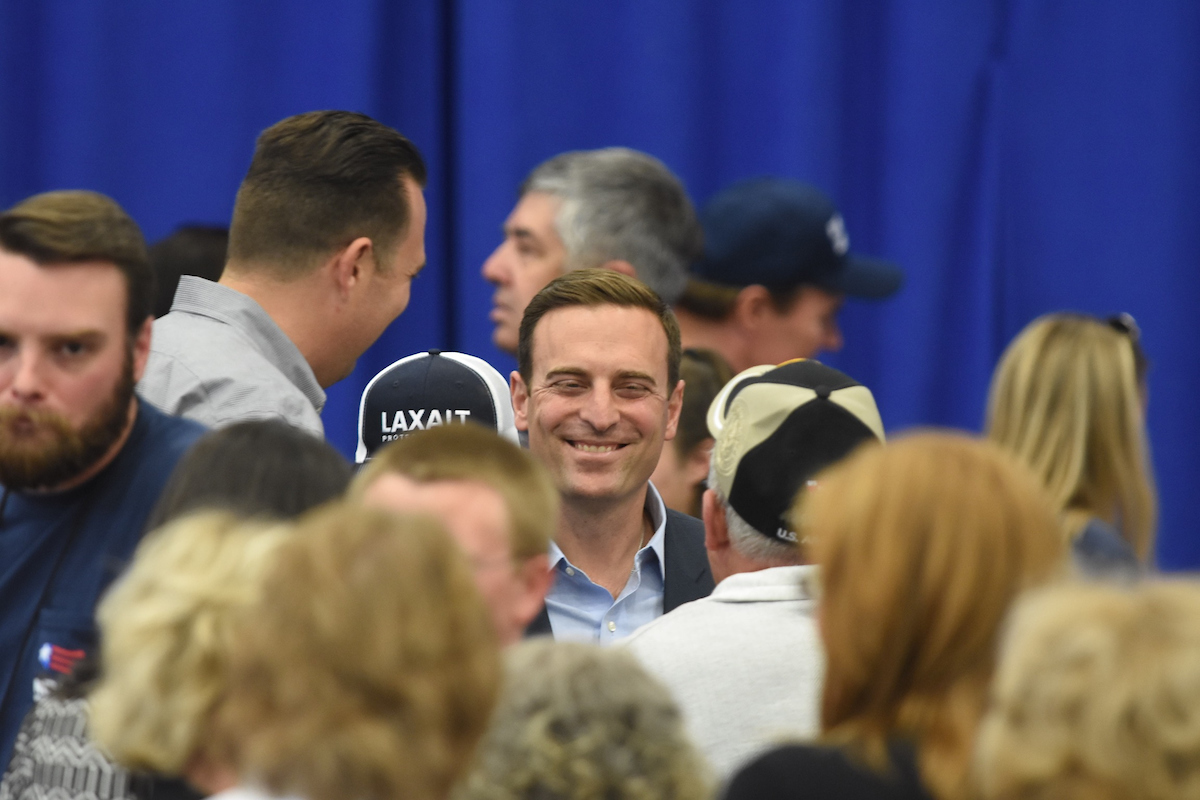
Laxalt: A political pedigree
Born in Reno on August 31, 1978, Laxalt spent his formative years in and around Washington, D.C., where his mother, Michelle Laxalt, was a successful Republican lobbyist and pundit. As a single mother, Michelle Laxalt raised her son with the help of her father, the late, highly respected former U.S. senator and Nevada governor, Paul Laxalt.
Laxalt was born of an affair between Michelle Laxalt and U.S. Sen. Pete Domenici, an older Republican senator from New Mexico and one of Paul Laxalt’s colleagues; Laxalt “didn’t know (his) dad growing up at all,” according to his first campaign commercial.
Through his family’s connections, Laxalt was exposed early in his life to Washington’s political juggernaut. Former Nevada Gov. Bob List, one of Laxalt’s advisers, said that Michelle Laxalt played a significant role in helping to shape her son’s political philosophy.
“He was just exposed to her logic and her point of view, and growing up in the Washington metropolitan area, you’re constantly inundated with debate and dialogue from both sides,” List said. “He took it all in.”
But asked in a recent interview with Fox 5 in Las Vegas about whether he wanted to go into politics from a young age, Laxalt said “never” and added that “no one had done any politics in our family for decades.” He explained that his grandfather had not been on the ballot since his victorious campaign for Senate in 1980. Paul Laxalt also briefly ran for president in 1987, eventually dropping the bid to co-chair former President George H.W. Bush’s successful 1988 presidential campaign.
As a child, Laxalt returned to Nevada to spend time with his family during the holidays and summers, including with his grandfather at Northern Nevada’s Marlette Lake, List said. His mother eventually married and had two daughters, Tessa and Tori.
In spite of his well-connected family, Laxalt had troubled teenage years. He started to drink as a student at St. Stephen’s and St. Agnes, a private prep school in Alexandria, and it continued to his college days at Tulane University in New Orleans. At 17, Laxalt was arrested on suspicion of assaulting a police officer and a year later was arrested for driving under the influence.
In a 1999 interview with the Washingtonian magazine, Laxalt described Tulane as “just too much fun, too many women, and too much booze.” Home for a break between semesters, Laxalt drove drunk one night home from his friend’s house and was pulled over by Alexandria police.
According to the Washingtonian, Michelle Laxalt was so upset with her son that she didn’t speak to him for two days. A lawyer advised “there was no way he could get me out of this” and that his only option would be to undergo treatment. The mother and son drove to Paul Laxalt’s office downtown, where the two told Laxalt that his bags were packed and that he would be leaving to attend a rehab program at the Hazelden Foundation near Minneapolis.
“Looking at my grandfather, whom I respect more than anyone with the exception of my mother, and to see how disappointed I made them was real rough,” he told the Washingtonian.
Laxalt initially resisted treatment, but he had an epiphany when his counselor told him he had a drinking problem and broke down crying for 20 minutes, he told the magazine. He returned home to Washington after completing the program, attended Alcoholics Anonymous meetings twice a week for the first few months and stopped drinking entirely.
Laxalt then enrolled at Georgetown University, where he graduated magna cum laude in 2001 with a bachelor’s degree and earned a law degree in 2005. He also worked as a special assistant to John Bolton, who was then undersecretary of state and is now the country’s national security adviser, and as a staff member for U.S. Sen. John Warner of Virginia.
In 2005, Laxalt joined the Navy, deploying to Iraq from 2006 to 2007 as a judge advocate general. A Navy performance report said he was responsible for reviewing, briefing, and presenting more than 1,400 detainee cases to panels of U.S. and Iraqi members. He was later promoted and supervised six paralegals and six officers as they tracked 35,000 detainee files.
When he returned to the United States, Laxalt taught at the Naval Academy. List said it was during that time that Laxalt met his wife, Jaime, thanks to a suggestion from none other than U.S. Supreme Court Justice Antonin Scalia, who he knew through his family.
As List tells it, Laxalt dropped in one day for a visit with Scalia, who asked where he was going to church. Laxalt said he attended church in Annapolis but was looking for a change, and Scalia recommended a parish in Virginia where his son was the priest.
“The following Sunday he attended Father [Paul] Scalia’s service and afterward walked up and spoke with Father Scalia, whom he knew, and said, ‘By the way, do you have any idea who that young lady was sitting down in the pew from me?’ and Father Scalia said, ‘Oh yeah that’s a young lady, her name is Jaime, do you want to meet her?’ So he introduced the two of them and that was it,” List said. “They soon got engaged and were later married by Father Scalia.”
When the conservative Supreme Court justice died in 2016, Laxalt attended Scalia’s funeral and issued a particularly personal tribute.
“I am deeply grieving the loss of Justice Scalia in two ways: as a friend, blessed by his kindness, and as an American, blessed by his wisdom,” Laxalt said in a statement. “He was by my account, and no doubt by many, the greatest jurist of our lifetime.”
Around the time he left the Navy, Laxalt started going public with his conservative positions through articles in the National Review, where he wrote on issues from defense spending to Don’t Ask, Don’t Tell. He penned some columns alone and others with Ron DeSantis, his roommate at the Naval Justice School in Rhode Island who is running for Florida governor as a Republican.
“Allowing homosexuals to ‘live out’ their sexuality and their relationships in the military would cause many problems,” Laxalt wrote in National Review in 2010. “Along with more sex comes more assaults, more sexual tension, and more of everything we already battle on a daily basis. Politicians must be able to step up and discuss this without fear of being slammed as bigots.”
Laxalt married in October 2011 and moved to Nevada, where he joined the law firm Lewis Roca Rothberger and was admitted to the bar in 2012. That year, he also co-founded the Nevada chapter of the St. Thomas More Society, an organization of Catholic lawyers.
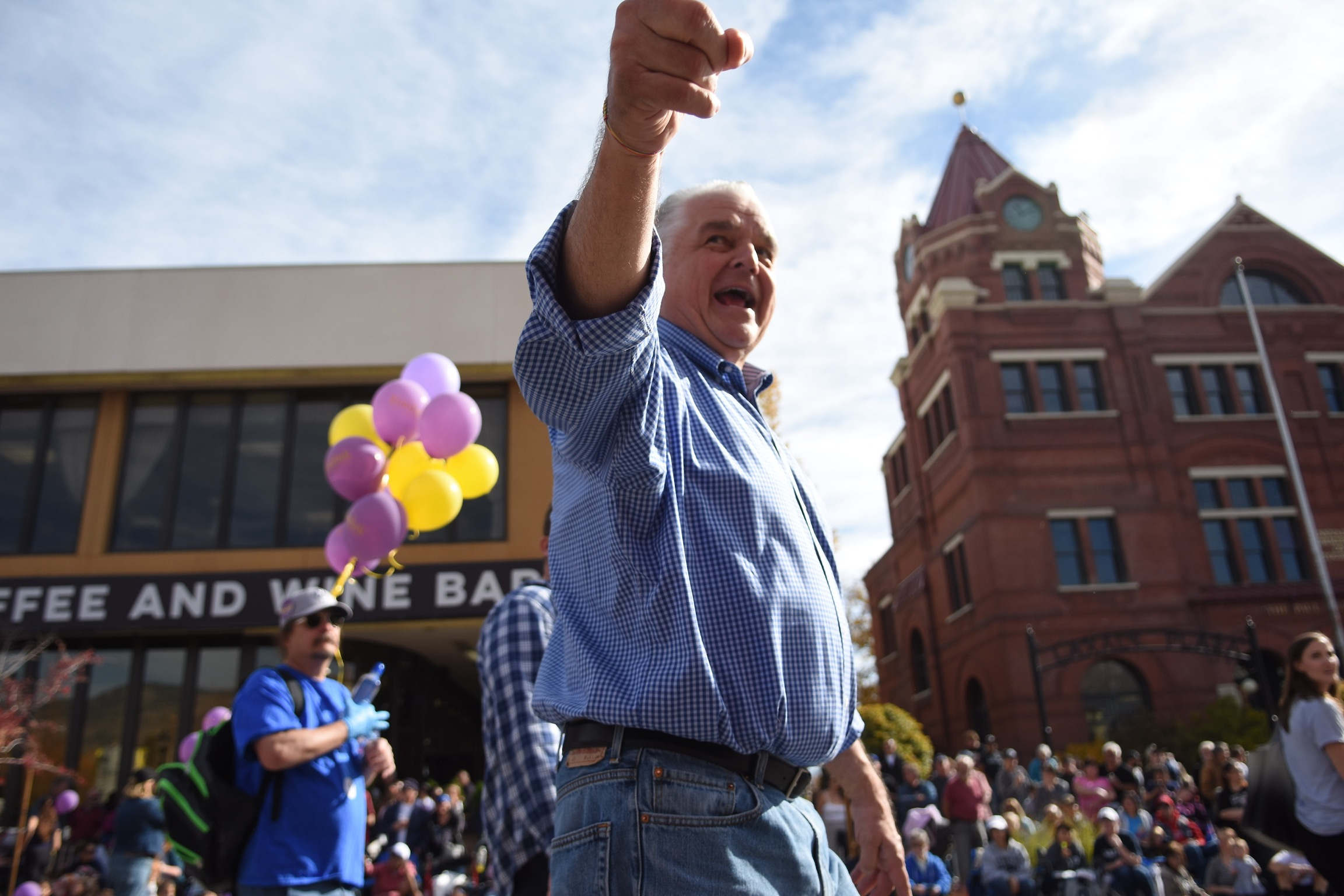
Sisolak: From Wisconsin to Nevada
Sisolak was born the day after Christmas in 1953, the middle of three children, and raised in the Milwaukee area. He describes his childhood as normal — his dad worked for General Motors for 34 years and his mom was a clerk at grocery stores including Piggly Wiggly.
He attended Wauwatosa West High School, where he was a member of the National Honor Society and student council. He lettered in basketball and also played football, track and golf, according to a Chamber of Commerce biography.
After earning a bachelor’s degree from the University of Wisconsin-Milwaukee in 1974, Sisolak started exploring his options for graduate school. He said he settled on UNLV for his MBA because California schools were too expensive and the weather was nice in Nevada. He’s lived in Nevada ever since.
To put himself through school, Sisolak worked at the California Club weighing coins inside slot machines to determine how much money was inside, he told the Las Vegas Review-Journal. He’d grab a free buffet breakfast after his 2 a.m. shift before going to class.
“That job was important to me. I was on my own. Even though rent was only $35, I didn’t have $35,” Sisolak told the paper. “I had to make that money in order to continue.”
He’s Catholic, and says his faith was strengthened in part by a near-death experience during a surgery in 1979.
After college, Sisolak went on to start two businesses, including American Distributing and Associated Industries. Opponents have described them pejoratively as telemarketing operations, but he characterizes them as business-to-business entities that sold custom-branded pens, mugs and other promotional materials and just happened to use the telephone.
In 1987, he married Lori Ann Garland and the couple had two daughters, Ashley and Carley. Garland filed for divorce in 2000, and Sisolak and the girls have filmed campaign commercials talking about his time as a single dad.
In the early 1990s, Sisolak emerged on the Nevada political scene during an effort to crack down on telemarketing scams. Then-state-Senate Minority Leader Dina Titus said he was tapped to be a member of a commission studying the matter and began to testify before the Legislature on proposed legislation to require telemarketers to register with the state instead of receiving a license.
“I met him when he was lobbying and we became friends,” she said. “There was a strong commitment to excellence. I thought that he gave good testimony, very well-prepared, very factual and very respected by colleagues on both sides of the aisle.”
Titus said she eventually tried to have him challenge incumbent Republican state Sen. Bill O’Donnell as part of an effort to secure Democratic control of the state Senate. His efforts to land a legislative seat in the 1990s failed — he lost by 10 percentage points in 1994, and by 5 percentage points when he challenged Ann O’Connell in 1996 — but it wasn’t the end of the road.
Gov. Bob Miller appointed Sisolak to replace Rory Reid on the Nevada Taxicab Authority in 1997. A year later, Sisolak was successfully elected to the Nevada Board of Regents, beating his opponent by 22 percentage points.
In 2001, Sisolak filed a lawsuit against McCarran International Airport, which is operated by Clark County. He alleged that a 10-acre plot he owned in southwest Las Vegas was losing value because of the expansion of the airport amid rules restricting the height of development nearby, and the increasing traffic, noise and fumes in the area.
After two years, a court sided with Sisolak, awarding him $15 million. He went on to sell his businesses in the mid-2000s and became a business consultant.
The court award has been the subject of Republican attacks, including in a recent fundraising email from Laxalt campaign manager Kristin Davison.
“He’s used a $15 million personal payout of taxpayer dollars to become a Clark County political kingpin,” she wrote. “He hands out contracts to his cronies and helps them get rich off of Nevada taxpayers, too!”
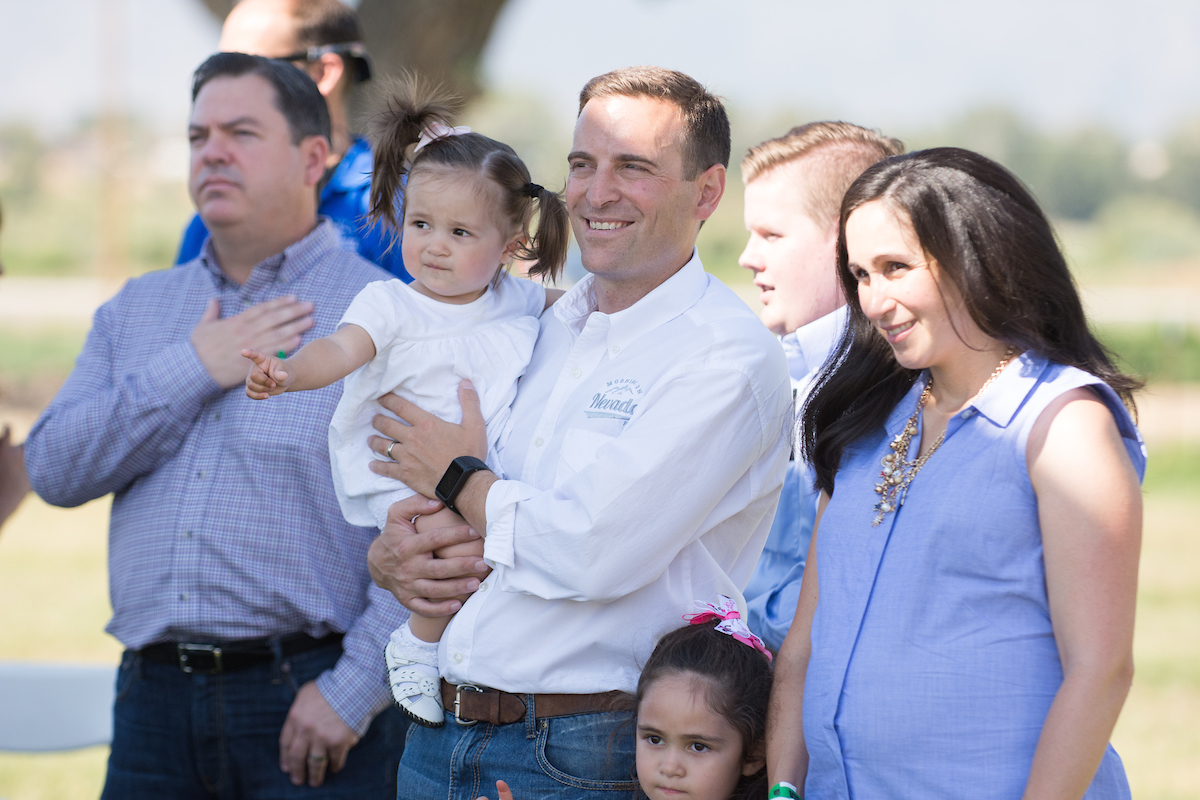
Laxalt’s rapid rise
Laxalt was relatively unknown when reports in 2013 revealed a long-held family secret: that Laxalt’s father was Sen. Domenici, who was married with eight other children and significantly older than Michelle Laxalt.
Laxalt has said little publicly about the family matter and it’s unclear how much he interacts with his father’s family, although Laxalt’s half-sister Nella Domenici has made an in-kind contribution to his campaign. When Domenici died last September at the age of 85, he issued a short statement.
“I am profoundly saddened by the passing of my father,” he wrote. “He leaves behind a wonderful, talented, and loving family. He was a great man who I will dearly miss.”
The revelation of his parentage helped clear the air ahead of Laxalt’s announcement that he would run for attorney general in the 2014 election against Ross Miller, the two-term Democratic secretary of state and son of the former Gov. Bob Miller.
"Most people were discouraging us, saying wait your turn," said Robert Uithoven, Laxalt’s top adviser in his 2014 and 2018 campaigns, in an interview with The Associated Press in 2015. "The more Adam heard that advice, the more it drove him to run."
The clean-cut, uniformed Laxalt cut a sharp profile in campaign ads even after the leak of a job review referred to him as a “train wreck” who didn’t “even have the basic skill set” and had “horrible client service toward his partners.”
But Laxalt’s nimble campaign swiftly batted back criticisms that he was not ready to take the state’s top law enforcement officer position and went on the offensive, questioning gifts that Miller had received in office. Observers were also critical of Miller’s debate performance — at one point, he suggested Laxalt was a paper-pusher in the military, and Laxalt turned it against Miller, who had not served in the military.
Laxalt also benefited from deeply depressed Democratic turnout during a midterm election in which Nevada had no Senate race or competitive governor’s contest. That led to a red wave and Laxalt’s one-point upset of the more established Miller.
Laxalt has framed his entree into the political scene as a new generation of Iraq War-era veterans taking up the mantle of leadership.
"If my race will signal one thing, it's to encourage the new generation to take these shots and to run,” Laxalt told the AP. "We need leadership today, not in a decade."
With help from a savvy team of deputies, Laxalt’s office created a “federalism unit” and embarked on a campaign against what it called the Obama administration’s federal overreach just as Obama’s term drew to a close and Congress deadlocked further against him.
One of Laxalt’s first moves as attorney general was to sign Nevada onto a lawsuit challenging Obama’s executive order expanding the Deferred Action for Childhood Arrivals (DACA) program and extending deportation relief to parents of DREAMers. He referred to the program in the 2015 forum with the Federalist Society as “executive amnesty.”
The lawsuit went to a Texas court, where a judge issued an injunction against Obama’s program. The U.S. Supreme Court — short one judge after Scalia’s death — deadlocked 4-4, allowing the injunction to stand.
Laxalt had similar success when he led 21 states in challenging the Obama administration’s effort to remove the “white collar exemption” that allows businesses not to pay overtime to employees in certain administrative roles.
The rule would have made about 4 million more workers eligible for overtime pay in the first year of implementation, but Laxalt argued it would be a crushing financial blow for government employers and businesses that would have new overtime payment obligations.
A judge later blocked the rule. The crusade earned him the endorsement of the conservative National Federation of Independent Businesses, but has been fodder for negative Spanish-language ads against him and critics who say it’s depriving 104,000 Nevadans of overtime protection and costing them $8 million a year.
Closer to home, Laxalt’s office mounted a vigorous defense of Nevada’s sweeping Education Savings Account program that allows parents to claim public school funds and steer them toward private school tuition or other qualifying education expenses.
He enlisted superstar lawyer Paul Clement, a former U.S. Solicitor General known for leading 26 states in a challenge of Obamacare.
In the end, the Nevada Supreme Court ruled the program’s funding mechanism was unconstitutional. But Laxalt’s office declared victory, saying the funding was a relatively easy fix and the real triumph was that the program was found to be constitutional on questions of separation of church and state.
A veteran himself, the attorney general has sought to carve a niche as a champion for veterans and sexual assault victims. He launched an Office for Military and Legal Assistance, a clearinghouse for lawyers working pro bono to help veterans and military families with their legal problems.
He’s taken up the mantle of clearing a backlog of untested sexual assault evidence kits. Helped by a federal grant that took effect just as he took office, Laxalt’s office has been able to send all but a few hundred of the nearly 8,000 untested rape kits to labs so far and has linked at least 17 arrests to DNA matches identified through the effort.
And he highlights that he created the first Elder Fraud Unit within the attorney general’s office. The project was backed by a federal Office on Violence Against Women grant and funds from a national mortgage fraud settlement Nevada landed after the recession.
Laxalt has not shied from getting involved in political campaigns. He was a strident opponent of Question 1, a measure backed by former New York City Mayor Michael Bloomberg that sought to expand background checks to more gun sales and transfers and appeared in ads opposing the measure.
He’s also received donations from the National Rifle Association and spoken at their major conferences, although he skipped the event this year in the wake of school shootings even though his picture briefly appeared as a featured speaker.
Although proponents of Question 1 eked out a razor-thin win, Laxalt had the last word when his office issued an opinion calling the ballot initiative “unenforceable” — the measure required background checks to be run through a federal database, which the Federal Bureau of Investigation said it would not allow. In spite of fierce criticism from political opponents that he and Gov. Brian Sandoval did not do enough to implement the voter-approved initiative, a judge later ruled that they made a good faith effort to do so.
Laxalt’s campaign has not answered a question from The Nevada Independent on whether, if elected, he would sign a similar background check bill into law.
He also opposed Question 2, an ultimately successful ballot measure to legalize recreational marijuana in Nevada. While his office has defended the law, he has offered few clues about his current thinking on the matter; Sisolak is the main beneficiary of marijuana industry donations and recently held a forum for the cannabis industry.
“My impression is (Laxalt) is not a very huge fan of the industry, but I think he also respects Nevada law and the will of the voters,” said Andrew Jolley, president of the Nevada Dispensary Association.
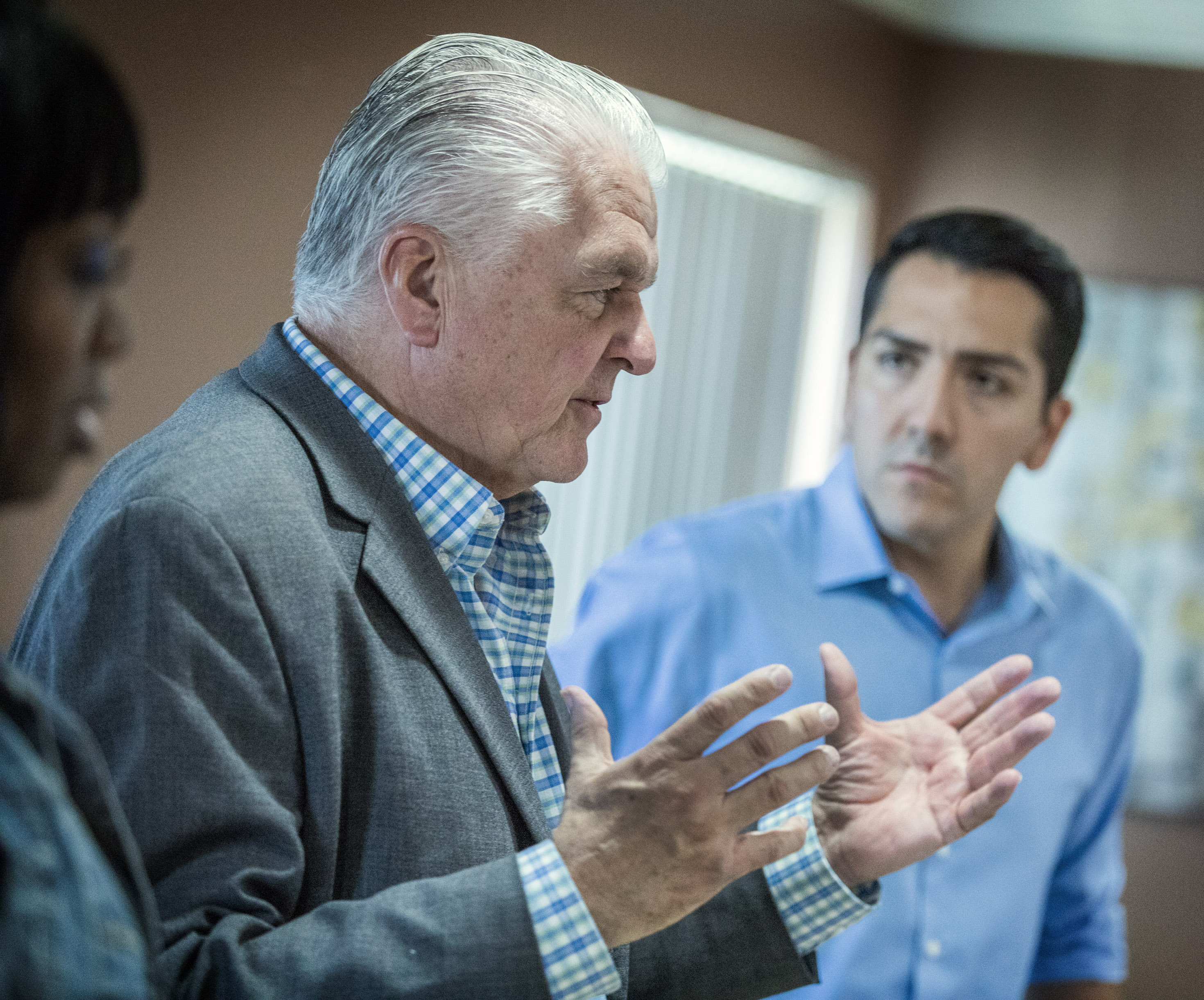
A strong personality
Some political newcomers like to stay quiet, testing the waters before they dive in. That was not the case for the outspoken Sisolak, who was often a thorn in the University of Nevada, Reno’s side in the decade he spent on the Nevada Board of Regents.
“Steve Sisolak of Las Vegas is the new kid on the block … but already he's become the squeaky wheel,” the Las Vegas Sun reported in 1999.
Only a couple of months into his term, Sisolak touched off a debate between UNR and UNLV by suggesting that there was a $3,000-per-student funding gap between the two schools.
Supporters of UNR pointed to a legislative study claiming that the disparity in funding was only $784 dollars, and UNR President Joe Crowley argued that his school needed more funding because of the older buildings it has to maintain. The regents eventually agreed to look into the funding gap and determined that the funding gap was only $534 per student; Crowley claimed victory.
The relationship between Sisolak and Crowley only worsened over the course of Sisolak’s first year as a regent as he continued to press Crowley with questions. At one point, Sisolak declined to attend a UNR fundraiser because he said Crowley swore at him.
When UNR tried to start dropping the “Reno” and call itself the “University of Nevada” in 2004, Sisolak was insistent that the university use the full name. He said that by dropping the Reno the institution was presenting itself as better than UNLV.
"They are equal," Sisolak told the Sun. "One is not a child of the other one, or an offshoot of the other one."
In an attempt to make amends with the Northern Nevada university this election cycle, Sisolak released an ad filmed at UNR and touting his support for the school while serving as a regent.
“This is our state’s first university, right here in Reno,” Sisolak says. “And it’s an economic hub for all of Nevada. That’s why when I served the Board of Regents we invested here in new centers for science, health, and academics.”
But Sisolak didn’t just reserve his criticism for the North. He was a frequent critic of the Nevada State College in Henderson, raising the specter during the process of developing the college that “back-room deals or meetings in the middle of the night” were responsible for moving the project forward so quickly. In 2002, a few months before Nevada State College was set to open, Sisolak and another regent asked that the board review the status of the college and determine whether to continue its operation or terminate it.
While Sisolak was a regent, the board also approved tuition increases, something Laxalt and his Republican supporters have seized on in the campaign. The Republican Governors Association has accused Sisolak in ads of allowing college tuition prices to more than double during the decade he spent as a regent.
Tuition did rise significantly at UNLV and UNR during Sisolak’s tenure as regent, according to a database on “sticker price” tuition costs compiled by the Chronicle for Higher Education.
And Sisolak voted in favor of subsequent 5 percent in-state tuition increases for the 2009-10 and 2010-11 school years in 2008. At the time, he defended the increases by saying they were necessary to meet rising education costs.
“I’m the first one who wants to avoid raising tuition but the costs of education are going up, professor salaries are going up,” Sisolak told the Sun in 2004. “We’ve got to have a tuition increase that is commensurate with our increase in costs, as long as we do everything to keep costs down.”
After a decade on the Board of Regents, Sisolak decided to take a shot at the Clark County Commission in 2008.
During the race, Sisolak faced questions from his Republican opponent Brian Scroggins about his telemarketing business. Scroggins accused Sisolak of drawing cease-and-desist orders for his telemarketing business and consorting with telemarketing lobbyists who went to prison for various crimes — claims that Sisolak dismissed at the time as “absolutely, categorically false.”
Sisolak, armed with his airport settlement, was also largely able to self-fund his campaign and amassed three times as much campaign cash as his opponent.
In the end, Sisolak bested Scroggins by 1.2 percentage points, or a total of 1,585 votes.
Transitioning to the high-profile commission role, Sisolak positioned himself as a business-friendly Democrat, vocally opposing several proposed tax increases.
Sisolak strongly opposed the More Cops tax increase in 2014, which would have raised the county sales tax by 0.15 percentage points so the county could afford to hire 150 to 200 additional police officers. At the time, Sisolak told KXNT radio that he didn’t believe that former Clark County Sheriff Doug Gillespie was providing accurate numbers in his effort to promote the tax.
But as the tax increase was folded into a funding package to build a football stadium for the Raiders — a project Sisolak strongly favored — he dropped his resistance to it. Sisolak justified his change in position in light of high-profile acts of terrorism around the world, saying “the situation has changed from a few years ago.”
Sisolak also opposed a teachers union-backed “margins tax” that was on the statewide ballot in 2014 and lost badly. At the time, he told the Review-Journal that struggling small business owners couldn’t afford the taxes and suggested a business tax based on profits and not overall revenue, as the margins tax had proposed. (In 2015, the Legislature eventually passed a similar gross-receipts tax known as the Commerce Tax, which has much lower rates than the margins tax.)
During the recession, Sisolak generally took fiscally conservative positions in opposition to some of his fellow commissioners, supporting layoffs rather than dipping further into the county’s reserves.
“There is nothing else to cut. There is no other place to look. The cupboard’s bare,” he said as county considered more than 500 layoffs. “It’s extremely difficult and concerning … I know we are dealing with people’s lives, careers and families.”
And while Sisolak is a favorite among many labor unions, he’s also clashed with some of them on the County Commission.
For instance, Sisolak butted heads with Clark County firefighters during the economic downturn during a time that the union was seen as too resistant to cut pay and benefits. Contract negotiations eventually and went to arbitration, which favored the county and led to a 2 percent wage reduction.
He also accused firefighters in 2010 of gaming the system by calling in sick when they weren’t ill so their colleagues could cover for them and collect overtime pay for doing so. Sisolak promised an audit of the sick leave policy.
Opponents have characterized him as a bully on the commission and cited a Review-Journal headline that referred to him as a “political bulldozer.” They have also raised questions about the close proximity between his approval of county contracts and the recipients making him campaign donations.
“I worked with Steve,” fellow commissioner Tom Collins wrote in a fundraising email for Laxalt with the subject line “Democrats for Laxalt.” “I saw him in action. His top priorities were always himself, his wallet, and his donors.”
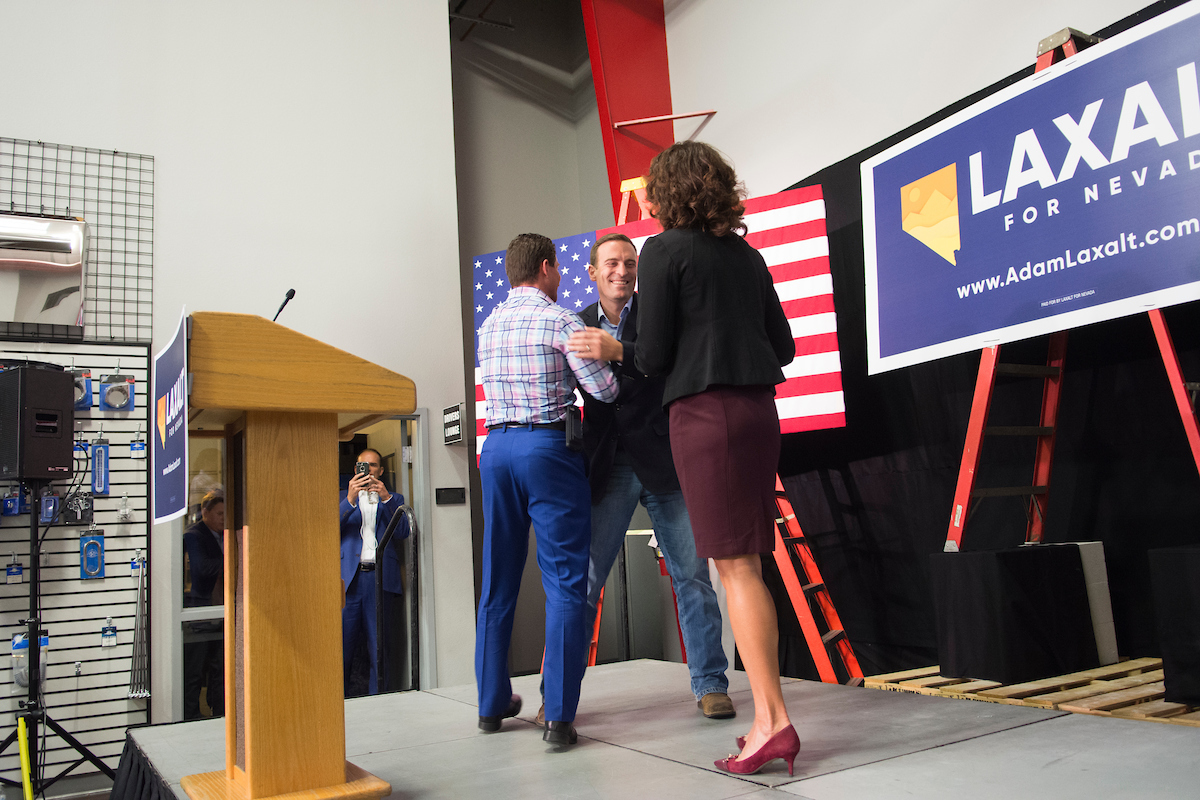
Education, a perennial priority
Both candidates have staked out improving education as their top priority. But their plans to do that have been the subject of many attack ads.
Democrats have pounded Laxalt for promising this summer, and repeating in several ads, that he would add $500 million to schools. Sandoval’s staff has said existing revenue sources could yield about $500 million more than current levels in the next biennium.
Even Sandoval has questioned the promise, saying that the revenue growth has already been more than spoken for by state agencies that have submitted their budget requests to his office. The growing number of people tapping into state services eat up much of the growth, and Sandoval asserted that fulfilling the $500 million promise would require either massive cuts or a tax increase (Laxalt has already promised no tax increases.)
Laxalt has declined to answer questions about the details of his plan and has avoided interviews on the matter. But former Gov. List offered some insight into the promise.
“I had a brief conversation with Adam about that, and his answer was, ‘Look, we’re going to find the money,” List said. “... He simply said, ‘It’s in the back of my mind right now. I know we have to do it.’ He said, ‘When this election is done then we’re going to dig in, and I can’t afford today to spend my time thinking about it or figuring it out just yet, but we will.’”
Meanwhile, Sisolak has offered almost identical, broad-strokes goals — smaller class sizes, more teacher pay, better career and technical training programs — as Laxalt, sans a dollar figure.
The Review-Journal editorial page has criticized him for not releasing plans with as much detail as a trio of Laxalt written platforms on career and technical education, health care and economic development (Sisolak since released a detailed health care platform and had issued an education platform during the primary).
“Laxalt also shows a better command of the details. He’s offered broad changes and in-the-weeds proposals,” the editorial said.
Titus pushed back on that.
“I think Laxalt’s hiding behind the written word,” she said. “Steve, in the meantime, is out there … talking to voters, answering questions, he’s at town halls. … So I don’t think these old white papers that Laxalt’s team’s putting out make any difference.”
Sisolak’s political opponents have launched numerous ads suggesting he wants to raise property taxes, airing video of him telling supporters that “one of the ways we’re going to have to pay for it, and people don’t want to hear it, is property taxes.”
Sisolak has been hard to pin down on the tax issue. In a debate with his primary opponent, he said “everything is on the table” and declined to promise no tax increases. But he has said he does not foresee a need to raise taxes in the immediate future, and has chosen his words carefully when talking about property taxes, which have not rebounded as quickly as the economy overall because of restrictions built into the property tax formula.
Former Clark County Manager Don Burnette wrote an op-ed in the Sun on Friday arguing that “the portrayal of (Sisolak) as a tax-and-spend elected official who is determined to raise property taxes could not be further from the truth.”
“In contrast to the representations made recently, Steve has been ‘vehemently opposed’ to increasing the property tax rate, which has stayed flat during his entire time in office,” Burnette wrote.
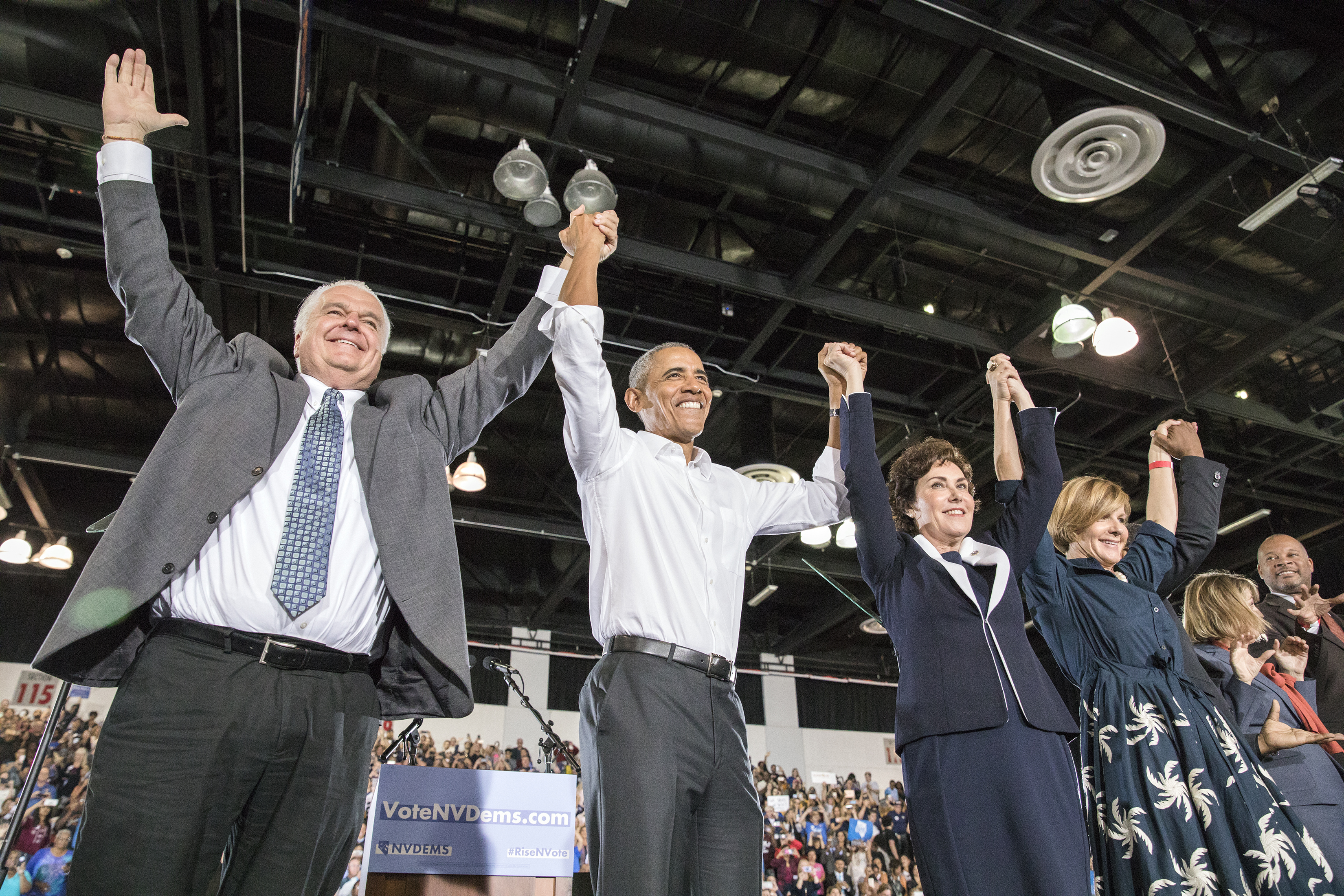
Health care attacks ramp up
Nevada’s next governor will also play a critical role in shaping the future of the health-care landscape in the state. Though there are a number of thorny issues the Legislature will likely confront during the next session, much of the campaign rhetoric has centered around the Affordable Care Act’s protections for pre-existing conditions as the country awaits the outcome of a federal lawsuit in Texas that could rule them unconstitutional.
Laxalt was a sharp critic of the federal health-care law during his 2014 campaign for attorney general, calling it “the most flawed piece of major legislation America has ever endured,” but his strong feelings on the Affordable Care Act date back further than that. In 2011, he co-authored a column with DeSantis in which they wrote that “no single act” of Congress in 2009 and 2010 “displayed its members’ indifference to Madisonian constitutionalism more than ObamaCare.”
The two men wrote that the law’s individual mandate to purchase health insurance — a provision effectively nullified by the tax reform legislation Congress passed in December — “affirmatively violates the Constitution” and that that other portions of the law “conflict with the philosophy underlying” the Constitution.
“Opponents of ObamaCare should continue to press the political case for repeal in a way that goes beyond mere dollars and cents,” they wrote. “Repeal is also about preserving an ethic of constitutionalism rooted in limitations on government, political accountability, and equal justice under the law.”
But as Election Day nears, Laxalt has sought to make a distinction between his opposition to the sometimes reviled health-care law as a whole and his support for the law’s protections pre-existing conditions, widely regarded as the most popular provision of the law. As Sisolak has hammered Laxalt on the issue — suggesting that the Republican attorney general would “let insurance companies deny people coverage, just because they have a pre-existing condition” — Laxalt has been equally eager to demonstrate his support for pre-existing conditions.
In late October, Laxalt released an ad featuring his mother talking about how she raised her children as a single mother in spite of her multiple sclerosis.
“When [Sisolak] says my son would deprive you of pre-existing condition coverage, he’s a liar. I am a pre-existing condition,” Michelle Laxalt says.
But Sisolak told the Independent that his campaign has continued to run the ads because he doesn’t believe Laxalt is sincere.
“We have been consistent with where we stand in terms of the expansion of Medicaid and pre-existing conditions,” he said. “Adam has kind of blown with the wind depending what the political pundits and polls say. That’s where he’s going, wherever he thinks he can capture votes.”
For his part, Sisolak has promised to sign a bill vetoed by Gov. Brian Sandoval during the 2017 legislative session that would incorporate the Affordable Care Act’s protections for pre-existing conditions into law. (In a veto message, Sandoval said that he supported provisions in the bill that would have protected people from being denied coverage from insurance companies but believed the law went too far in other areas.)
Laxalt’s campaign has not answered emailed questions about what he would specifically do to enshrine protections for people with pre-existing conditions or whether he would sign into law the measure vetoed by Sandoval in 2017 that would codify parts of the Affordable Care Act into Nevada law.
The two also differ on abortion. Sisolak has run ads talking with his daughters talking about how they used services from Planned Parenthood, and the group has endorsed him. By contrast, the ardently pro-life Laxalt has an endorsement from anti-abortion rights group Nevada Right to Life.
Laxalt got in hot water the night of his primary victory when asked whether he would look to roll back abortion rights and he answered “we’ll look into it.” Nevada voters enshrined the right to an abortion through the first two trimesters in the state constitution in 1990, and Laxalt’s campaign has since said he has no interest in repealing the provision.
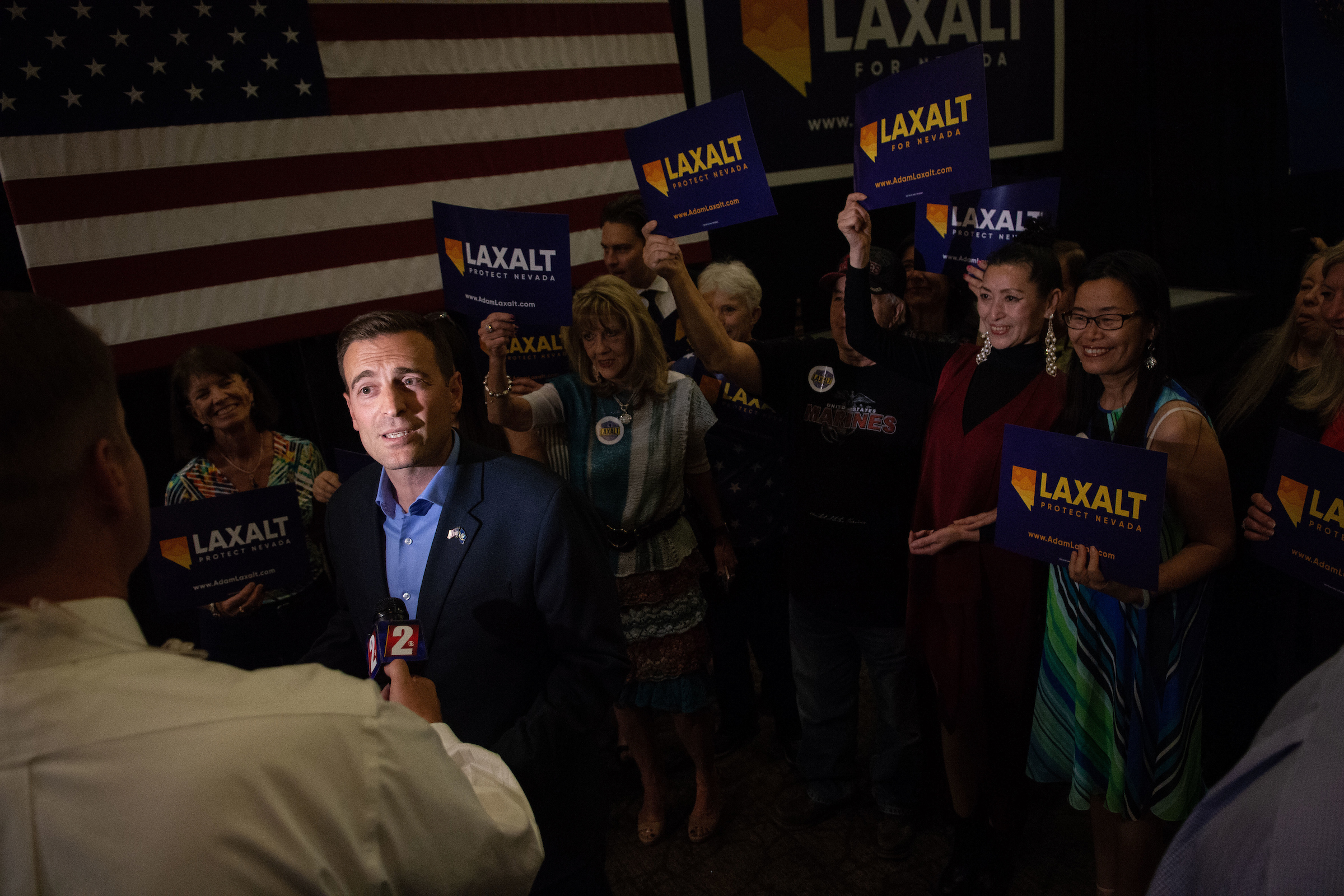
Getting personal
Ads against Sisolak have sought to portray him as a corrupt politician entangled in pay-to-play deals, and contrast him with Laxalt, who wants to “protect Nevada.”
Many use a body double portraying a hunched Sisolak slinking in a field at night. One cites a 2008 story in which KLAS-TV reported Sisolak was “of interest to the FBI Agents and Metro detectives” in an investigation involving an alleged threat made against state Supreme Court candidate (and current Justice) Kris Pickering.
Sisolak's team has gone as far as making an ad countering the claim.
"That attack launched by the Laxalt team is categorically false," said Sisolak campaign spokeswoman Christina Amestoy. "Steve was never the subject of an FBI investigation nor was he ever questioned by the FBI in connection with the case."
His opponents have pointed to a 2010 Review-Journal story that reported a federal judge “chastised” Clark County commissioners — including Sisolak — and said they acted “corruptly” when they awarded a union contractor a valuable highway construction project with a bid $4.6 million higher than a competing non-union builder.
“It’s surprising that a judge would go that far in mischaracterizing an elected official,” Sisolak said after the ruling, which the newspaper reported in early 2010.
But the accusations have gone beyond their jobs and into their personal relationships.
An opposition website, ShadySteve.com, accuses his lawyer of helping him “helped him discredit a teenage girl who accused him of improper behavior.” That refers to accusations from 2012 by Sisolak’s ex-girlfriend, Kathleen Vermillion, who said at the time that he had been uncomfortably familiar with her then-15-year-old daughter.
This summer, Vermillion renounced her former claims against him, saying they stemmed from a substance abuse problem.
The two sides have also stoked a feud within the large, extended Laxalt family. As they did in the 2014 campaign, a group of family members submitted an op-ed to the Reno Gazette-Journal recommending voters oppose Laxalt.
“The irony is that while moving to Nevada to satisfy his enormous political ambitions, he has proceeded to oppose others’ rights to come to our state,” they wrote. “In the face of Nevada’s history as a state made of newcomers, including our own immigrant forebears, he has advocated against immigrants as well as against businesses and individuals who have moved here from other states.”
That triggered 22 family members to sign onto an op-ed defending him.
“It was his commitment to principle that drove him to try to do the impossible, and we could not have been prouder of him for it,” they said of his improbable 2014 victory. “He has amassed an incredible record of bipartisan accomplishment that has made Nevadans safer today as a result.”
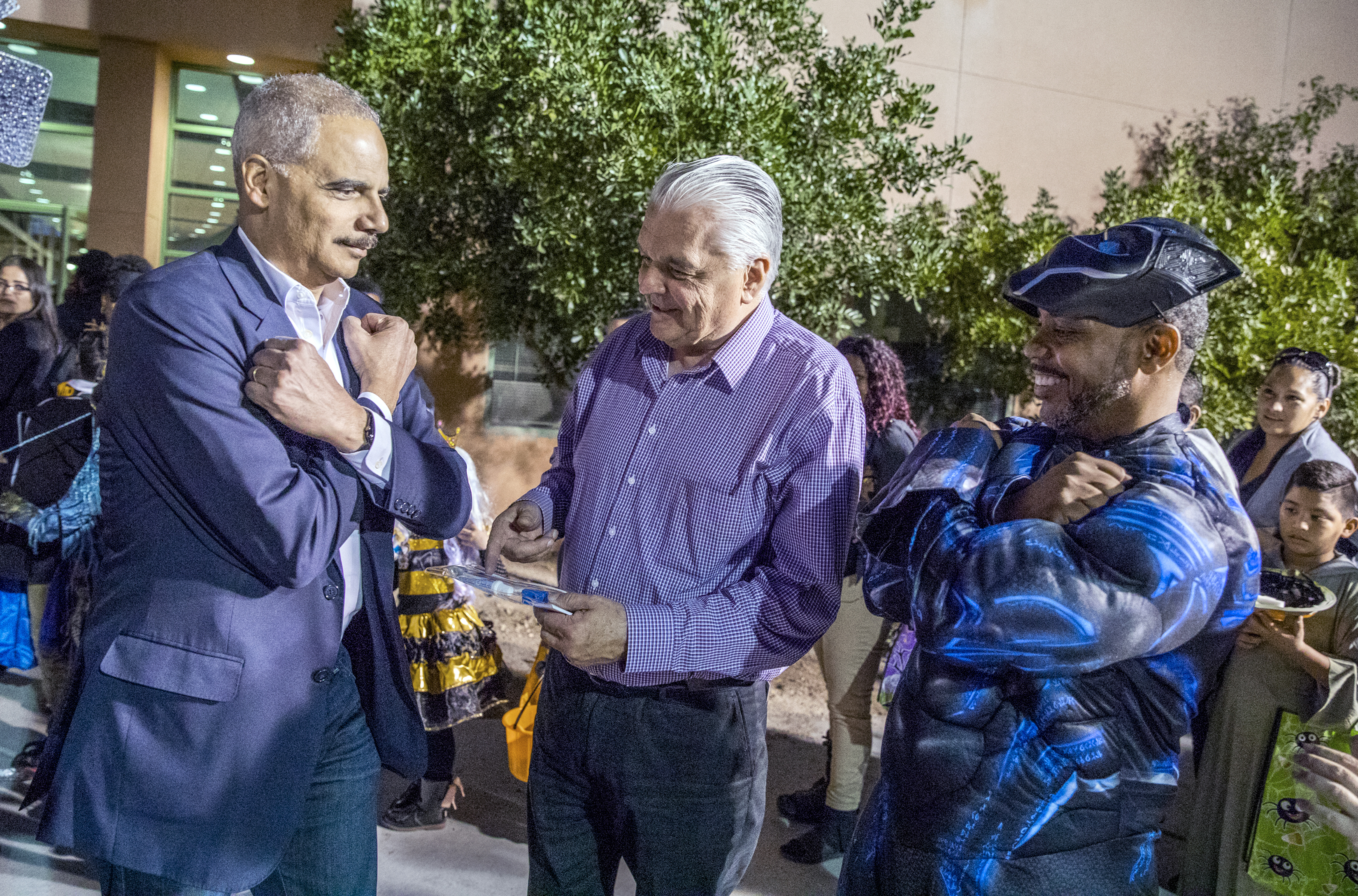
An expensive contest
Whoever wins the race to be Nevada’s next governor won’t have done so on the cheap. Since the beginning of the calendar year, Sisolak has raised $7.4 million and spent $13.3 million, while Laxalt has brought in $6.2 million and spent $8.7 million.
But third-party groups that are free of contribution limits have far outpaced both candidates in both fundraising and spending in the race. More than two dozen political action committees registered with the Nevada secretary of state’s office reported raising more than $34 million and spending $33.9 million over a 10-month period, primarily in the gubernatorial race.
Sisolak has more on his side. For example, in the four month period between June 8 and Oct. 12, PACs supporting Laxalt raised more than $9.9 million and spent $11.9 million, while those supporting Sisolak raised $15.2 million and spent $13.3 million.
On the Democratic side, Nevada Families First has been the most prolific of any outside group over the four month period between June and October, raising $6.3 million and spending $5.1 million. The PAC’s biggest contributor is the Democratic Governors Association, which transferred more than $3.6 million to it; other top donors include Everytown for Gun Safety, the labor super PAC Working for Working Americans, former Attorney General Eric Holder’s National Democratic Redistricting Committee, the Service Employees International Union’s political arm, and a business owned by Democratic megadonor Stephen Cloobeck.
The top player on the Republican side has been the RGA Nevada PAC, the local arm of the Republican Governors Association, which has raised $8.7 million and spent $8.8 million over the same four-month period. The RGA’s top contributors in 2016 — the most recent year for which records are available — were the Las Vegas Sands, Blue Cross/Blue Shield and Koch Industries.
Democratic groups have run ads highlighting $2.5 million in contributions to Laxalt from entities linked to conservative billionaires Charles and David Koch, and his support of efforts to stave off an inquiry into whether ExxonMobil downplayed the effects of climate change. The inquiry would have affected companies funded by the Koch brothers, who are considered pariahs in liberal circles.
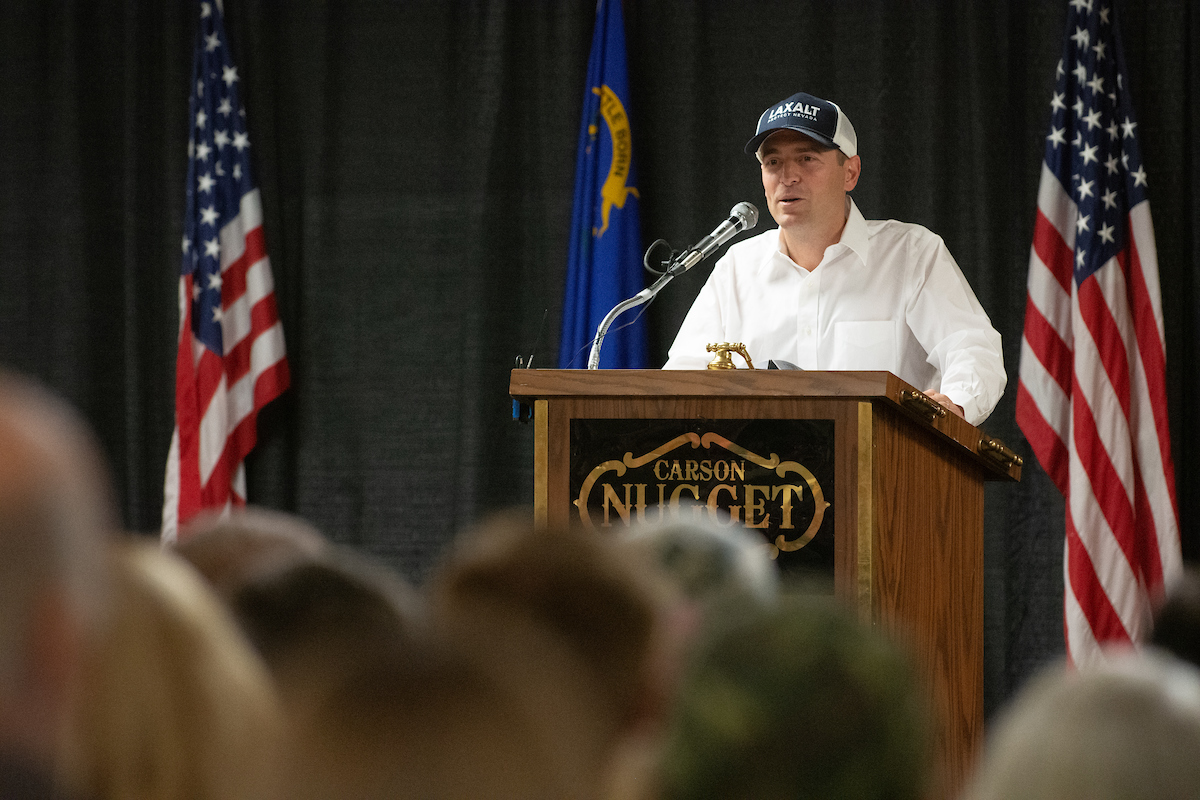
On the ground
Both sides have mounted aggressive ground games. The Democratic Party and its fabled Reid Machine have gained a reputation over the last several cycles for their ability to turn out massive numbers of voters to the polls, but the Republicans have upped their game this year.
The Republican National Committee, taking a page out of the Obama playbook, built a massive voter data program and landed on the ground in Nevada this cycle in June 2017, earlier than ever before.
Laxalt has paid particular attention to rural Nevada — he scored his 2014 victory by driving up enough votes in the deeply Republican terrain to offset losses in Clark and Washoe counties. He has talked often of his kickoff tour hitting all 17 counties and enlisted a long list of rural county commissioner as supporters; in the last week or so, he’s tweeted photos of himself campaigning in Winnemucca, Yerington and Fallon.
William Kasten, who attended a rally with Vice President Mike Pence in Las Vegas last month, said he supported Laxalt because he thought he was well-qualified and a “decent” man, but it also boils down to balance.
“If the state’s going to have a Democrat-controlled Legislature, I want a Republican governor,” he said. “I want the check and balance in place. In California what we had is … a Democratic supermajority. They didn’t have to ask Republicans for any assistance at all.”
Sisolak, meanwhile, has had a major boost from unions that fund hundreds of canvassers. Groups including the AFL-CIO, which credit the Raiders stadium project that Sisolak championed for a boom of construction jobs, are drawing on a voter registration and turnout strategy that helped Nevada turn blue in 2016 and is viewed as an example by national union leadership.
Sisolak acknowledges he has not campaigned in some of the most rural parts of the state, but he is ubiquitous at trunk-or-treat events, Dia de Los Muertos festivals and union gatherings in the population centers. On Tuesday, Sisolak was in the rec room of a senior apartment complex in East Las Vegas that was decked with cutouts of pumpkins, vampires and a mummy.
He came bearing Winchell’s donuts, and a dozen or so seniors who had gathered to hear him air complaints that were less about big-picture issues like education and more about bus routes, the lack of lighting in the complex, recent gang violence in the area. He steered the conversation to campaign talking points, but not before calling out to an aide in the back to remind him he needed to ask someone named Mike to check on the bus issue.
“It was good to meet him in person. He seemed like a good person, humble,” resident Gilberto Gonzalez, 65, said in Spanish after the visit. “He seems like someone who’s going to be for Nevada, for the community here.”
Laura Soto, 73, didn’t need convincing. She said she had already voted for Sisolak and Democrats down the ticket because she wants better schools for her grandchildren.
“It breaks my heart to know teachers have to have yard sales to buy supplies,” she said. “That’s just not right.”
